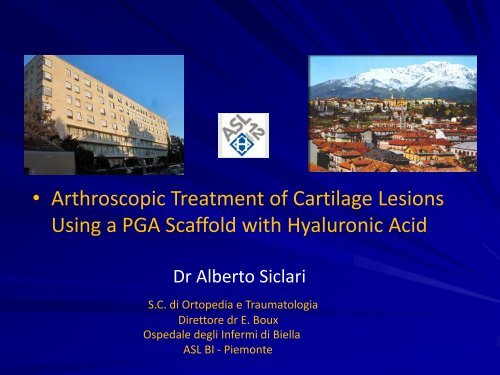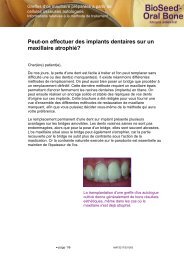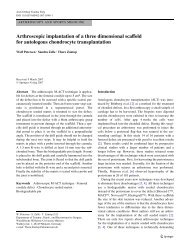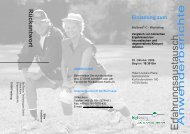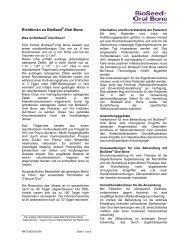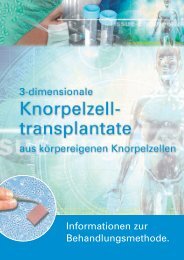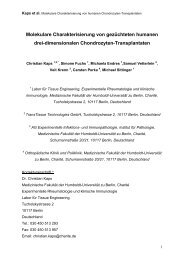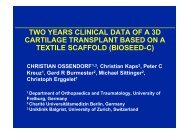Create successful ePaper yourself
Turn your PDF publications into a flip-book with our unique Google optimized e-Paper software.
• Arthroscopic Treatment of Cartilage Lesions<br />
Using a PGA Scaffold with Hyaluronic Acid<br />
Dr Alberto Siclari<br />
S.C. di Ortopedia e Traumatologia<br />
Direttore dr E. Boux<br />
Ospedale degli Infermi di Biella<br />
ASL BI - Piemonte
• The management of cartilage loss continues to<br />
be a challenge to trauma and orthopedic<br />
surgeons<br />
• The introduction of pluripotent mesenchymal<br />
stem cells into the clinical settings opens new<br />
horizons
• Can we maximize the mesenchymal cells<br />
potential to produce cartilage ?<br />
• Can we use a simple procedure ,<br />
with low impact for the patient ,<br />
to restore damaged cartilage ?<br />
• Can we report these results<br />
to have a good follow up?
• Yes , we can ! .....<br />
• ( Thank you Mr President.......)<br />
• But , we need also .....<br />
1) a scaffold<br />
2) a grownth factor<br />
3) A lot of mesenchimal stem cells<br />
to produce a hyaline-like cartilage .<br />
So we can say that .........
Cartilage is just like a skyscraper<br />
Then we add<br />
growth factors<br />
that attract ......<br />
......... the<br />
Mesenchymal<br />
cells and stimule<br />
to differentiate<br />
them ....<br />
... in<br />
chodroblasts<br />
to produce<br />
cartilage<br />
At first we put a<br />
scaffold
1) The scaffold<br />
• Polyglycolic acid + hyaluronic acid scaffold<br />
chondrotissue ®<br />
( BioTissue )
• Macromolecolar<br />
polymer<br />
• High hidrophily<br />
• High viscoelasticity<br />
High stress resistence<br />
• Totally reabsorbable
2) Growth factor<br />
• <strong>Platelet</strong> <strong>Rich</strong> <strong>Plasma</strong> (<strong>PRP</strong>): divided from the<br />
other blood fractions by centrifugation
<strong>Platelet</strong>s if activated release the alfagranules<br />
in the extracellular matrix.<br />
We can find three kinds of GF that have<br />
proliferative and differentiative effects :<br />
1) TKR GF ( TyrosineKinase Receptor ) (PDGF)<br />
2) SMAD GF ( SerineThreonine KinaseR.) (BMP<br />
+TGF Beta)<br />
3) FGF ( Mitogen-activated Receptor?)
FGF ( Mitogen-activated Receptor?)<br />
• FGF = Fibroblast GF<br />
• Probably it works like a regulator<br />
• It’s an antagonist of BMP and induce MSCs to<br />
develop into fibroblasts and not in<br />
chondroblasts<br />
• Minina E , et al. “Interection of FGF and BMPsignaling integrates chondrocytes proliferation “ Dev Cel<br />
2002;3:439-448
How do they work ?<br />
Grownth Factors<br />
• Receptors in cell membrane<br />
• Activation of a transcription factor ( Sox9 mainly)<br />
• Nucleus<br />
• Activation of a gene ( or genes ?)<br />
• Proliferation or differentiation
3)Mesenchymal stem cell MSC
• Mesenchimal stem cells are non-haemopoietic<br />
stromal cells that exhibit a multilineage<br />
differentiation capacity.<br />
• MSC can develop into chondrocytes, osteoblasts,<br />
myocites, neural cells and adipocytes<br />
• It’s possible to guide MSC into a specific type using<br />
specific grownth factors or other subtances<br />
( chondrogenesis : toluidine blue stain )<br />
• MF Pittinger et al.Multilineage potential of adult human MSCs Science 1999;<br />
284 :143-7
• Mobilisation and differentiation of MSC are<br />
influenced by chemotaxis and by interaction<br />
with the extracellular matrix .<br />
• However , MCS are influenced by<br />
microenviroment<br />
• WR Otto Tomorrow’s skeleton staff MSC and the repair of bone and cartilage<br />
Cell Prolif 2004 ; 37: 97-110
• Mesenchymal stem cells can be recovered in<br />
articulation and in a collagenic scaffold after<br />
microfractures.<br />
• J. Kramer et al. “In vivo matrix-guided human mesenchymal stem cells”<br />
Cellular and molecular life sciences 2006,vol 63 n°5 pp. 616-626
Clinical Application<br />
• 1) cartilage lesions of the knee<br />
• 2) cartilage lesions of the talus<br />
• 3) hallux rigidus
The idea<br />
Cartilage Lesion<br />
Curettage<br />
Microfracture for MSCs to come in scaffold<br />
Positioning of the scaffold<br />
Grownth factor<br />
Cartilage
Clinical Application: the KNEE<br />
From July 2007 to September 2009 we treated:<br />
• 97 patients with chondral lesions of the knee<br />
for a total of 111 surgeries
• MRI<br />
• Lesions<br />
grade 3-4<br />
Diagnosis
• Chondral lesions of the knee : 65% tibial and<br />
35% femoral<br />
• 21 patients had a kissing lesion<br />
• The largest lesion was 5 cm2 • The average age was 44.8<br />
• 68% women 32 % men
The procedure<br />
• The surgery is completely done by arthroscopy<br />
and consists of three parts:
• In the 1 st part the subchondral bone is exposed by removing<br />
the damaged cartilage and microfractures are performed.
• In the 2 nd part the scaffold<br />
( chondrotissue ® ,<br />
BioTissue) is soaked with<br />
<strong>PRP</strong> and is implanted in<br />
the lesion .<br />
• If the lesion is femoral the<br />
scaffold is fixed with a<br />
resorbable pin .
• In the last part of the<br />
procedure the scaffold<br />
is covered and soaked<br />
with a gel obtained from<br />
the <strong>PRP</strong>
• The patient is discharged after few hours.<br />
• After 15 days the patient may walk with<br />
crutches and a partial load for one week and<br />
then with normal load.
Results<br />
• 52 patients have been evaluated with the<br />
KOOS score :<br />
pre-OP and then after 3, 6, and 9 months
Rule out<br />
• The exclusion criteria were: present infections,<br />
important articular instability, haemophilia,<br />
allergy to the scaffold constituents,<br />
alterations of the femoro-tibial angle > 2°,<br />
nocturnal pain caused by overload<br />
• Age limits: 25-65 years
• The average pre-OP score was 38.55 pts :<br />
during the first control the value rose to<br />
62.45 , during the second one to 63.58 ,<br />
during the third one to 65.87 , and during the<br />
fourth one to 69.97 ( p-value
Symptoms<br />
Pre-OP : 56.3 +- 10<br />
First control : 75.2 +- 9<br />
Second control : 78.7 +- 7<br />
Third control : 86.4 +- 8<br />
Pain<br />
Pre-OP : 54.1 +- 15<br />
First control : 78.2 +- 8<br />
Second control : 83.3 +- 8<br />
Third control : 89.6 +- 9<br />
Daily activities<br />
Pre-OP : 68.1 +- 18<br />
First control : 78.5 +- 17<br />
Second control : 82.7 +- 14<br />
Third control : 85.3 +- 15 Sport<br />
Pre-OP : 35.5 +- 14<br />
First control : 57.7 +- 19<br />
Quality of life<br />
Pre-OP : 37.2 +- 13<br />
First control : 59.7 +- 14<br />
Second control : 65.4 +- 10<br />
Third control : 70.5 +- 9<br />
Second control : 62.4 +- 12<br />
Third control : 68.8 +- 13
• Average KOOS<br />
• Pre-OP : 50.78<br />
• First control : 70.06<br />
• Second control : 74.70<br />
• Third control : 80.12
• 7 patients had a kissing lesion<br />
• Average age 44.3 yr ( 31-65 yr)<br />
• Average follow up 13.07 m ( 9-17 months)
• 10 patients have been re-evaluated with a<br />
second arthroscopic look 9 months after the<br />
first implant with a biopsy and a histological<br />
examination.
• The arthroscopic appearance during the<br />
second look was a cartilaginous tissue, whiter<br />
than the other cartilage, smooth but with<br />
some little corrugation, with a consistence<br />
similar to normal cartilage, stuck to the bone
• The histological examination reported in all<br />
10 cases the complete disappearance of the<br />
scaffold and the presence of a new<br />
cartilaginous tissue similar to hyaline<br />
cartilage.
• Struttura Complessa di Medicina Rigenerativa<br />
• Director Prof. Ranieri Cancedda<br />
• Department of Biology, Oncology and Genetics,<br />
University of Genoa
Complications<br />
• In 7 cases an articular effusion was drained<br />
with a needle during ambulatory controls. No<br />
infections or TVP were reported.<br />
• The range of motion was reduced of 20-30°<br />
in the first month, and gradually rose to the<br />
pre-OP level in the first three months.
Discussion<br />
• Clinical results are favourable : only after the<br />
first control the score increases by 19.28<br />
points. 90<br />
80<br />
•<br />
70<br />
60<br />
50<br />
40<br />
30<br />
20<br />
10<br />
0
• The possible explanation is found assessing<br />
the features of the scaffold used : its structure<br />
is very hydrophilic and inside the articular<br />
cavity it works like a “pillow” in the lesion<br />
giving soon a smooth and elastic surface .
Clinical Appliacation: the ANKLE<br />
• 8 patients with chondral lesions of the talus<br />
• All lesions were superomedial<br />
• 6 patients with positive anamnesis for ankle<br />
distorsion
Notes on the preliminary results<br />
• Short follow-up : 3-15 months<br />
• Loading recovery after 15 days<br />
• Fast pain relief<br />
• No complications, moderate post-OP pain<br />
• Unaltered range of motion<br />
• No arthroscopic second look
Clinical Application: the FOOT<br />
• Hallux Rigidus<br />
• Grade 0 ( FD 40-60° )<br />
• I ( FD 30-40° )<br />
• II ( FD di 10-30° )<br />
• III ( FD < 10° )<br />
• IV ( sub-ankylosis)<br />
• Coughlin –Shurnas 1999
• Cheilectomy<br />
• Osteotomy F1<br />
• Arthroscopy<br />
• Metatarsal ostetomy<br />
Suggested treatments<br />
• Arthroplasty with biological implant<br />
• silicone implant<br />
• metal implant<br />
• Arthrodesis
Indications<br />
• Grado 0 arthroscopy<br />
• I arthroscopy<br />
• II arthroplasty with scaffold<br />
• III arthroplasty with scaffold<br />
• IV artoplasty with scaffold/arthrodesis
Results<br />
• 17 patients for a total of 19 feet<br />
• 7 of grade II<br />
• 8 of grade III<br />
• 4 of grade IV<br />
• Follow-up 12-21 months
• AOFAS Score<br />
• average pre-OP value 61,3<br />
• average post-OP value 91<br />
• average pre-OP ROM value 24,5<br />
• average post-OP ROM value 56,3
As Leonardo would<br />
write.... uoY knaht ro<br />
...........................<br />
Thank you!


